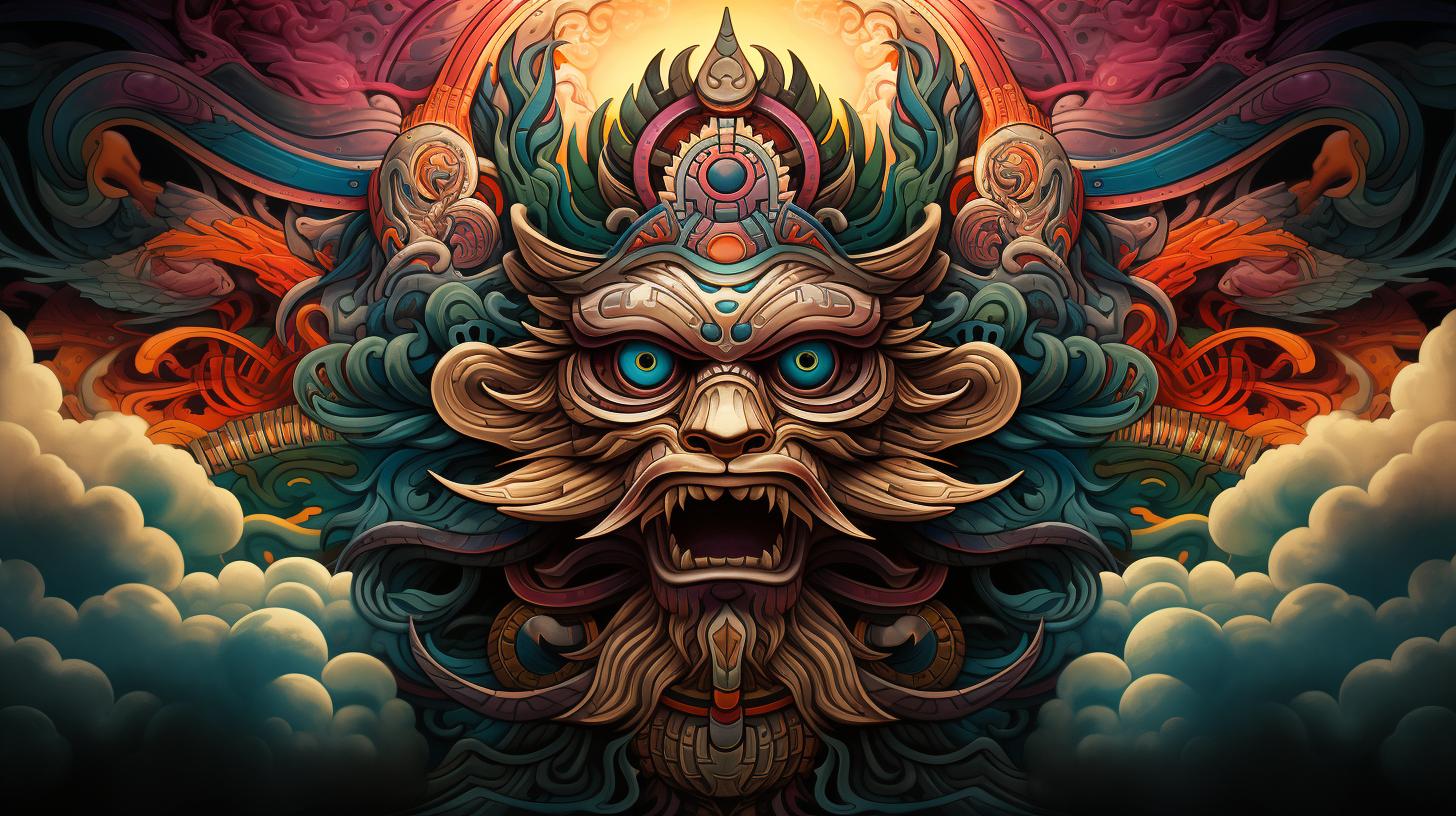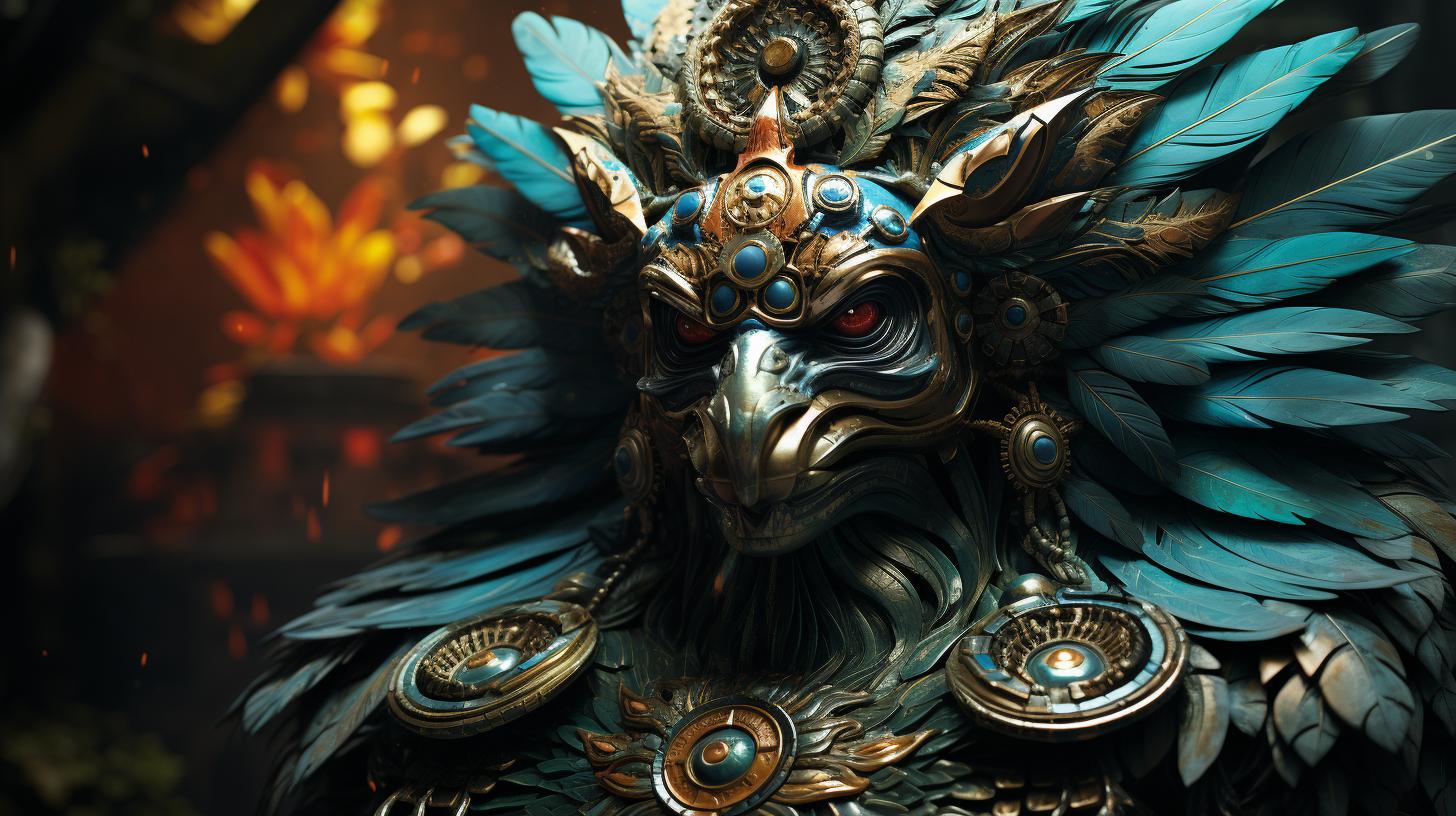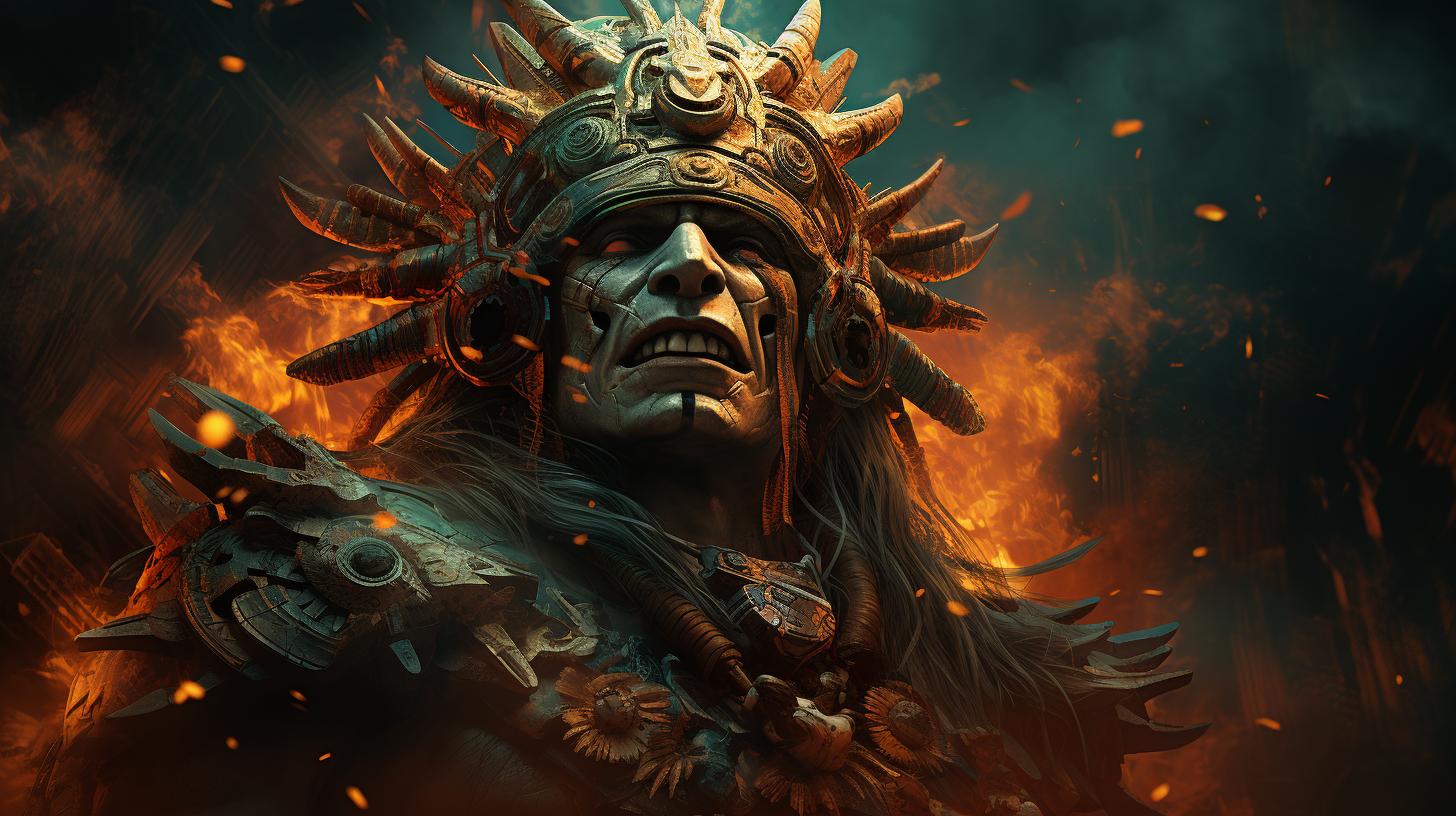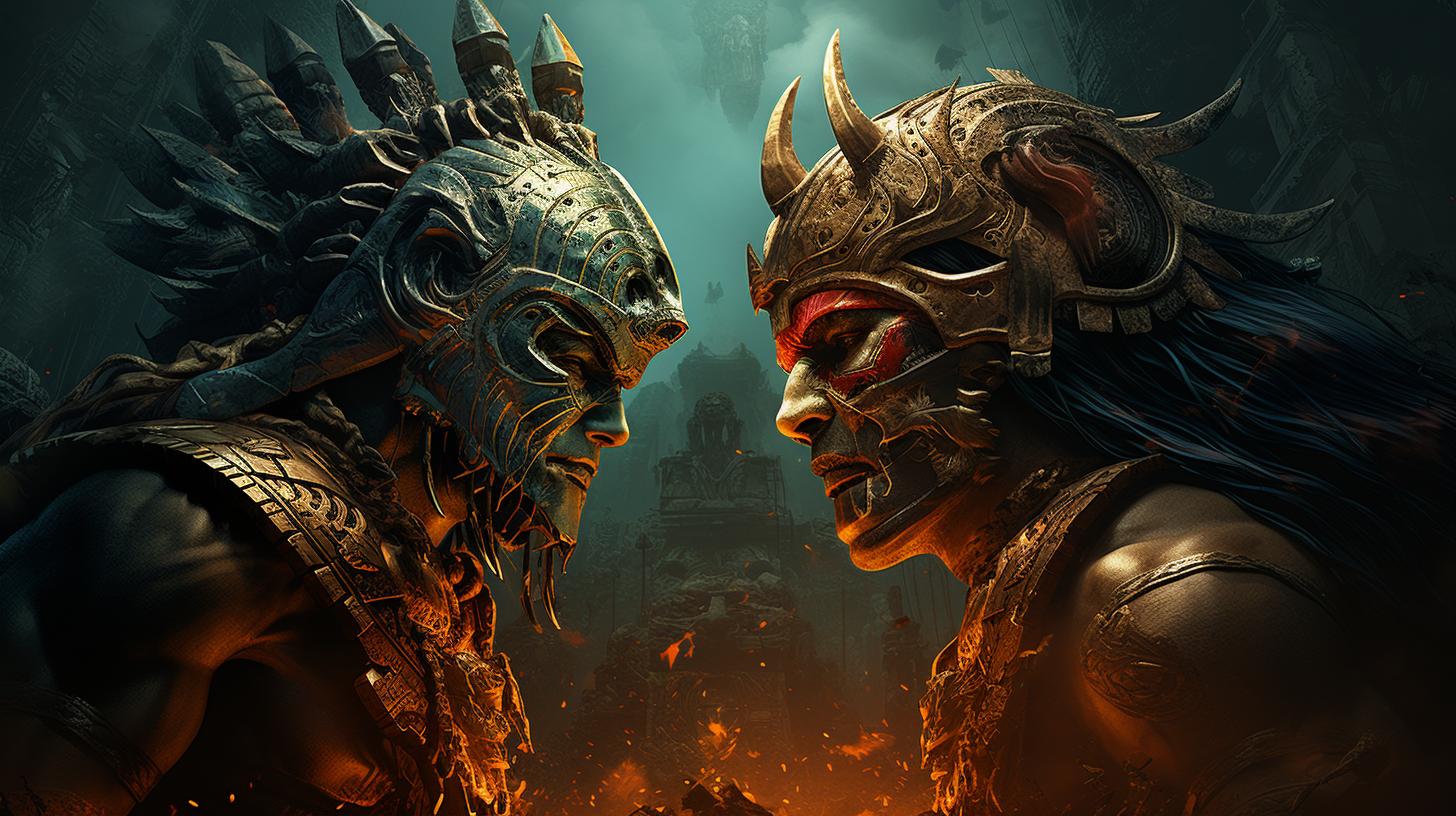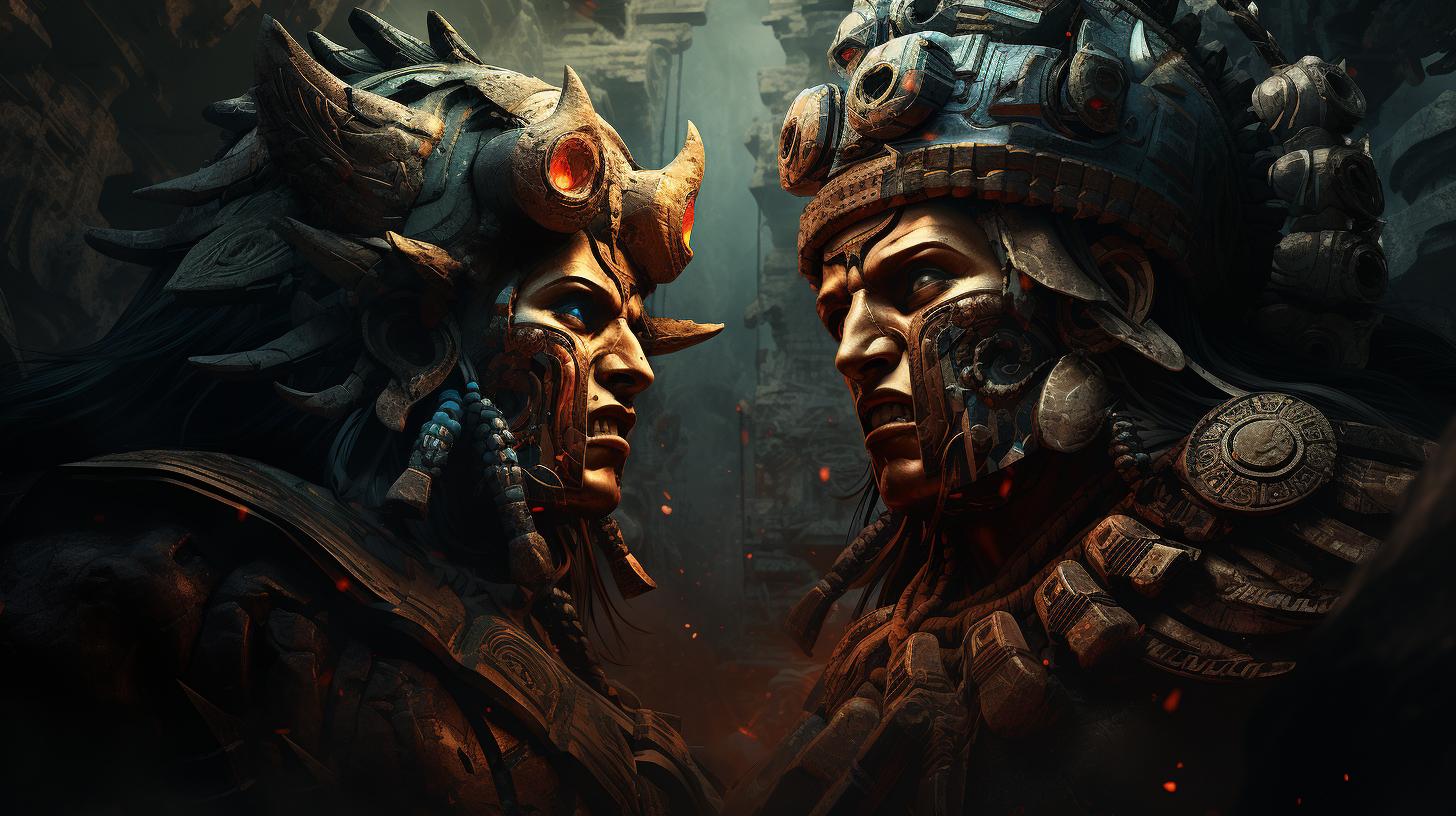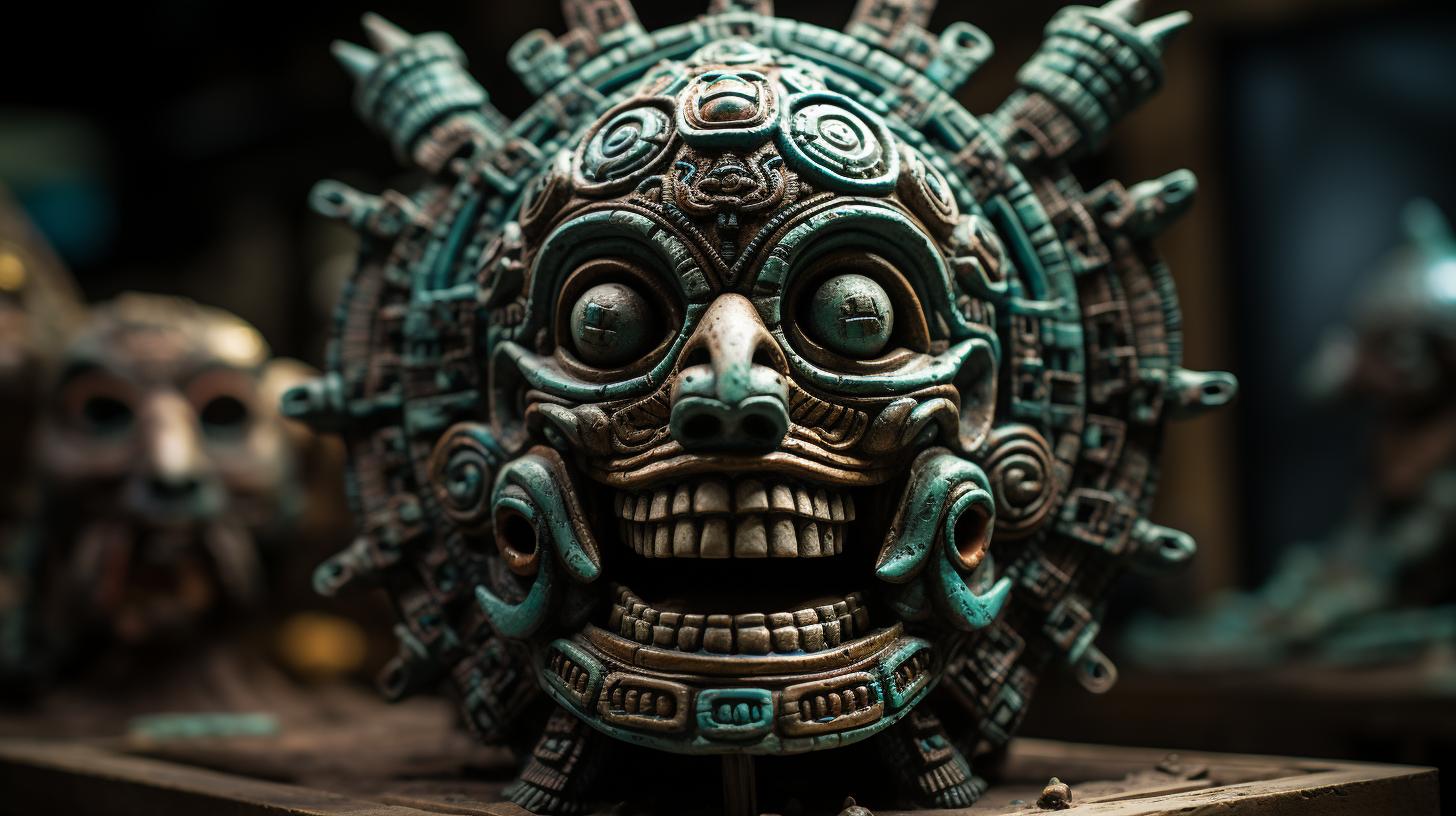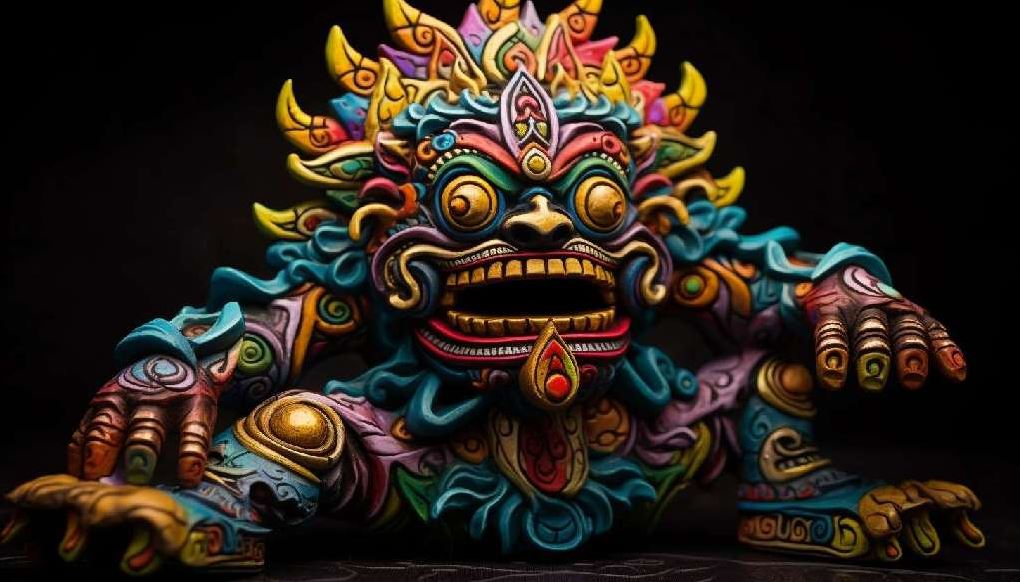Gucumatz: The Mighty Mayan God of Rain and Wind
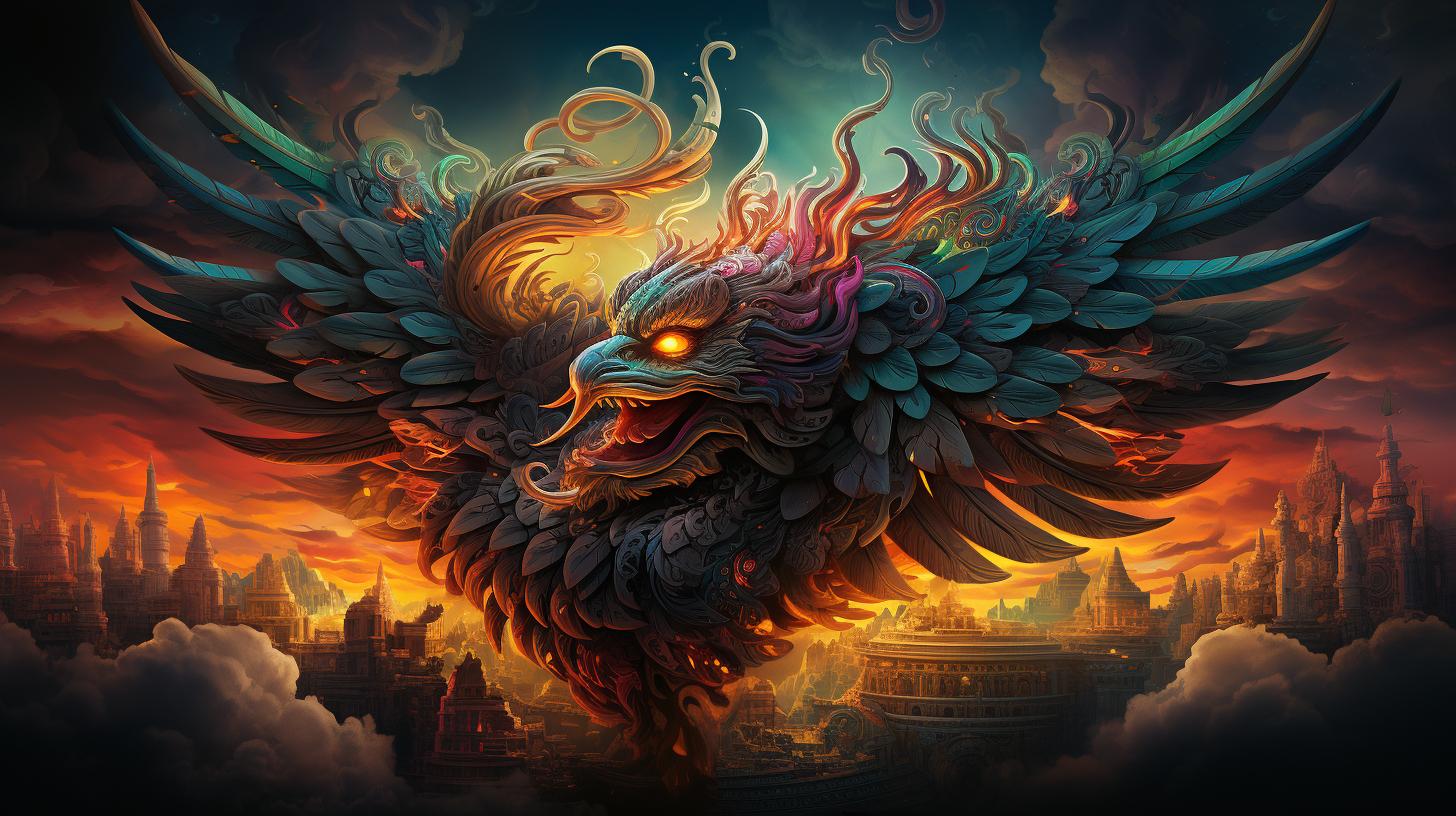
Gucumatz, also known as the Mayan god of rain and wind, holds great significance in Mayan mythology. According to the Popol Vuh, Gucumatz, along with Tepeu, played a vital role in the creation of the world and humanity.
The name “Gucumatz” derives from “qʼuq” referring to the resplendent quetzal bird, and “kumatz,” meaning serpent. Associated with water, clouds, and the sky, Gucumatz acted as a mediator between the forces of the Maya cosmos.
Through this article, we will delve into Gucumatz’s role as a deity, his interactions with other gods, and his influence on Mayan society and cosmology.
Origins of Gucumatz: Exploring the Mayan Mythology
Origins of Gucumatz delve deep into the rich tapestry of Mayan mythology, unraveling the ancient beliefs and stories surrounding this enigmatic deity. Within Mayan cosmology, Gucumatz played a vital role in the creation of the world and humanity.
This section explores the intriguing creation story of Gucumatz and Tepeu as the creators, shedding light on their divine powers and significance in Mayan culture.
The Creation Story: Gucumatz and Tepeu as the Creators
In the Mayan creation story, Gucumatz and Tepeu emerged as powerful gods who brought the world into existence. They collaborated closely, wielding their divine abilities to shape and populate the earth.
Gucumatz’s influence as a creator deity extended to various facets of the natural order, ranging from the landscapes to the intricate details of human physiology.
The story emphasizes Gucumatz’s creative prowess, as he and Tepeu meticulously fashioned humans from different substances, including earth and maize dough. This intricate process showcases Gucumatz’s deep connection to the cycle of life and the intricacies of existence.
Gucumatz and the Feathered Serpent Symbolism
Symbolism plays a significant role in understanding Gucumatz’s essence within Mayan mythology. Represented as a feathered serpent, Gucumatz embodies the harmonious integration of different realms, combining elements of the avian and serpent worlds.
This fascinating iconography represents the interplay between terrestrial and celestial forces, signifying Gucumatz’s role as a mediator between the earthly and divine realms.
The feathered serpent motif further highlights Gucumatz’s association with wisdom and knowledge, as serpents were revered in Maya culture for their connection to the underworld and supernatural realms. The quetzal feathers adorning Gucumatz represent resplendent beauty and serve as a reminder of the deity’s divine presence and power.
Gucumatz as the God of Rain and Wind
Gucumatz, the Mayan god of rain and wind, played a vital role in Mayan society and mythology. Let’s delve into his significance in two key aspects: his role in Mayan agriculture and his association with water and the sky.
Role of Gucumatz in Mayan Agriculture
Gucumatz was revered by the Maya for his pivotal role in agricultural practices. As the god of rain, he was believed to bring the much-needed water for crops, ensuring fertile soil and bountiful harvests.
Farmers offered prayers and rituals to Gucumatz, seeking his favor and blessings for a prosperous yield.
Moreover, the Mayans saw Gucumatz as a provider of balance in the natural world. They believed that his influence over the rain and wind patterns helped maintain a harmonious equilibrium in the ecosystem, thus ensuring the overall well-being of agricultural communities.
Gucumatz’s Association with Water and the Sky
Beyond agriculture, Gucumatz was deeply associated with the elements of water and the sky. As the god of rain, he controlled the life-giving rains that nourished the land. Mayans regarded him as the bringer of both gentle showers and torrential downpours, recognizing the dual nature of his power.
In addition to rain, Gucumatz’s connection with the sky was profound. He was hailed as the deity responsible for the movement of the sun across the heavens during the day. This celestial journey represented the cycle of light and darkness, symbolizing the cyclical nature of life itself.
Gucumatz’s association with both water and the sky emphasized his vast influence over the fundamental aspects of existence. The Maya celebrated and revered him for his power to bring life-sustaining rains and control the celestial movements that dictated the rhythm of their lives.
Qʼuqʼumatz as the Mediator Between Cosmic Forces
Qʼuqʼumatz, the Mayan god also known as Gucumatz, played a crucial role as the mediator between the different forces within the Maya cosmos. As a powerful deity, Qʼuqʼumatz interacted with other Mayan gods, influencing the balance and harmony of the universe.
Gucumatz’s Interactions with Other Mayan Deities
In the intricate tapestry of Mayan mythology, Gucumatz engaged in significant interactions with various gods. One notable association was with Tepeu, with whom Gucumatz collaborated in the creation of the world and humanity.
Their combined efforts shaped the fundamental aspects of the Mayan cosmos, demonstrating Gucumatz’s role as a divine creator.
Additionally, Qʼuqʼumatz’s influence extended to other gods of the Mayan pantheon. For instance, Gucumatz was connected to Chaac, the god of rain, symbolizing the vital link between rain and wind for the sustenance of life.
Through these divine connections, Gucumatz ensured the harmonious interactions between different natural forces, maintaining the order of the universe.
The Importance of Qʼuqʼumatz in Mayan Rituals
Qʼuqʼumatz held significant importance in Mayan rituals and ceremonies, as his mediation between cosmic forces was believed to have a direct impact on human existence. Ancient Mayan communities revered and honored Gucumatz through rituals, offerings, and prayers, seeking his blessings for fertility, abundance, and prosperity.
During important agricultural seasons, Mayan farmers would perform rituals dedicated to Qʼuqʼumatz, acknowledging his role in ensuring bountiful harvests. These rituals involved ceremonial dances, incense burning, and offerings of sacred food and drinks, all aimed at establishing a harmonious relationship with the deity and securing his favor.
The role of Gucumatz in Mayan rituals extended beyond agriculture. He was also invoked in religious ceremonies for healing, protection, and guidance. Shamans and priests acted as intermediaries between the human realm and the divine, channeling the power of Qʼuqʼumatz to bring about spiritual well-being and maintain cosmic harmony.
In conclusion, as the mediator between cosmic forces, Qʼuqʼumatz played a pivotal role in Mayan mythology and society. His interactions with other deities and his significance in rituals showcased his influence in shaping the Maya cosmos and ensuring the well-being of humanity.
Gucumatz in Mesoamerican Culture and History
The significance of Gucumatz, the Mayan god of rain and wind, extends beyond the mythological narratives and finds a prominent place in Mesoamerican culture and history. This section delves into Gucumatz’s presence in various texts and artifacts, highlighting its enduring influence throughout the region.
Gucumatz in the Popol Vuh: Mythological Text of the Maya
The Popol Vuh, the sacred book of the Maya, offers valuable insights into the mythology surrounding Gucumatz. It recounts the creation story, presenting Gucumatz as one of the key deities responsible for shaping the world and humanity.
The Popol Vuh describes Gucumatz in conjunction with Tepeu, symbolizing their collaborative efforts in the act of creation.
This mythological text holds Gucumatz in high regard, emphasizing its role as a mediator between cosmic forces. Gucumatz’s association with celestial elements, such as the sun, sky, and water, underscores its divinely influential presence in Maya cosmology.
The Popol Vuh also explores the symbolism of Gucumatz as the feathered serpent, further cementing its significance in Maya religious beliefs and cultural practices.
Gucumatz in Other Mesoamerican Cultures
While Gucumatz holds a central position in Mayan mythology, the deity’s influence extends beyond the Maya civilization. Gucumatz, known by various names in different Mesoamerican cultures, is a recurring figure in their respective mythologies.
In Aztec culture, Gucumatz finds its counterpart in Quetzalcoatl, a revered deity associated with wisdom, wind, and creation. The similarities between Gucumatz and Quetzalcoatl reveal the interconnectedness and shared beliefs across Mesoamerican civilizations.
Gucumatz’s presence can also be traced in the mythology of other pre-Columbian cultures, such as the Olmec and Toltec civilizations. Although the interpretations and representations may differ, the reverence for Gucumatz as a divine entity remains consistent within the broader Mesoamerican cultural framework.
- Mentioned in the Popol Vuh as a key creator deity
- Symbolized as the feathered serpent, representing cosmic forces
- Associated with celestial elements like the sun, sky, and water
- Shared beliefs with Quetzalcoatl in Aztec culture
- Influence observed in the mythologies of other Mesoamerican civilizations
Legacy of Gucumatz in Modern Interpretations and Beliefs
Gucumatz, the Mayan god of rain and wind, continues to hold a significant place in modern interpretations and beliefs, particularly within contemporary Maya communities.
The legacy of Gucumatz lives on through worship and reverence, as well as symbolic representations in art and architecture.
Gucumatz Worship and Reverence in Contemporary Maya Communities
Within the vibrant Maya communities of today, Gucumatz is revered as a powerful deity and is an integral part of their spiritual practices. The worship of Gucumatz involves rituals, ceremonies, and offerings to honor his role as the mediator between different cosmic forces.
It is through these acts of devotion that the Maya seek blessings of abundant rainfall, fertile lands, and harmony with nature.
Maya communities gather in sacred spaces, such as temples and ceremonial sites, to pay homage to Gucumatz. These gatherings are filled with prayers, chants, and dances, all aimed at connecting with the divine energy represented by the mighty Mayan god.
The reverence for Gucumatz highlights the deep-rooted cultural and spiritual significance he holds within the Maya community.
Symbolic Representations of Gucumatz in Art and Architecture
The legacy of Gucumatz extends beyond worship and permeates Maya art and architecture. Symbolic representations of Gucumatz can be found in various forms, showcasing the reverence and respect for this influential deity.
- Artistic Depictions: Paintings, sculptures, and drawings depict Gucumatz as a feathered serpent, embodying the duality of the resplendent quetzal bird and the powerful serpent. These artistic representations capture the awe-inspiring nature of Gucumatz and serve as a reminder of his connection to the elements.
- Architectural Elements: Gucumatz’s symbolism is also infused into architectural designs of temples and sacred structures.
Intricate carvings and reliefs depicting the feathered serpent adorn the facades, entrances, and interior spaces of these structures. Such architectural marvels not only showcase the Maya’s artistic prowess but also serve as physical embodiments of the deity’s presence.
Through art and architecture, the Maya preserve and perpetuate the legacy of Gucumatz, ensuring that future generations continue to recognize and honor the importance of this divine figure in their cultural and spiritual heritage.
The Influence of Gucumatz on Mayan Society and Cosmology
Gucumatz, the powerful Mayan god of rain and wind, held great significance in Mayan society and cosmology. Through various connections to temples, sacred sites, and ancient Mayan cosmology, Gucumatz played a pivotal role in shaping the belief system and practices of the Maya people.
Gucumatz’s Connection to Temples and Sacred Sites
Gucumatz’s influence extended to the construction and significance of temples and sacred sites in the Mayan civilization. Temples dedicated to Gucumatz served as spiritual centers where rituals and ceremonies took place, allowing the Maya to express their devotion and seek divine intervention.
These architectural marvels showcased intricate designs, symbolic carvings, and stone sculptures depicting Gucumatz and other deities.
- Gucumatz Temple in Qʼumarkaj: Located in the city of Qʼumarkaj, this temple was a prominent religious site where worship and offerings were made to Gucumatz. It served as a gathering place for spiritual leaders and the community to connect with the divine forces.
- Sacred Caves and Natural Springs: Gucumatz’s association with water led to the veneration of sacred caves and natural springs as places of spiritual significance.
These natural formations were believed to be gateways to the spiritual realm, where contact with Gucumatz and other deities could be established.
Gucumatz’s Significance in Ancient Mayan Cosmology
Within the intricate web of Mayan cosmology, Gucumatz held a key role in maintaining cosmic balance and harmony. His interactions with other deities and cosmic forces influenced the Mayan understanding of creation and the divine order of the universe.
Gucumatz as the Mediator Between Cosmic Forces
Gucumatz played a crucial role as the mediator between the various cosmic forces within Mayan cosmology. He balanced opposing elements such as sky and earth, light and darkness, rain and drought.
The Maya believed that Gucumatz’s mediation ensured the continuity of life, agricultural abundance, and prosperity.
The Importance of Qʼuqʼumatz in Mayan Rituals
Gucumatz’s significance translated into the performance of elaborate rituals and ceremonies by Mayan priests and community members. These rituals sought to actively engage with Gucumatz, seek his blessings, and honor his role in the cosmic order.
Offerings, chants, dances, and sacred objects were central to these rituals, reinforcing the spiritual connection between the Maya people and Gucumatz.
Gucumatz’s influence on Mayan society and cosmology was profound, shaping their religious practices, architectural marvels, and understanding of the universe. Today, the legacy of Gucumatz continues to resonate in the hearts and minds of the contemporary Maya community, preserving their rich cultural heritage and spiritual traditions.
…

